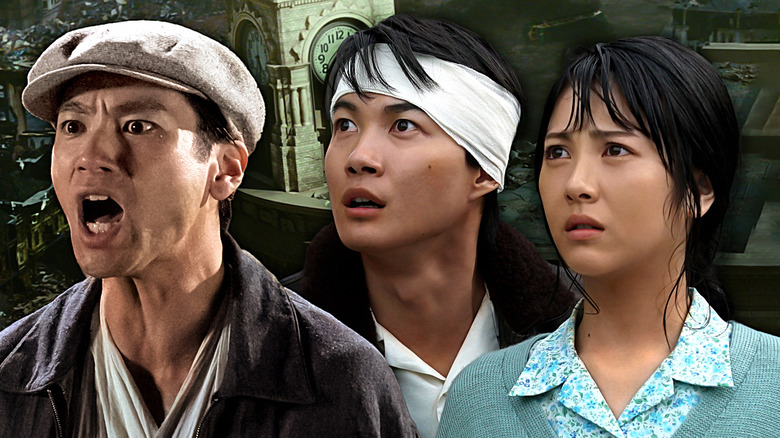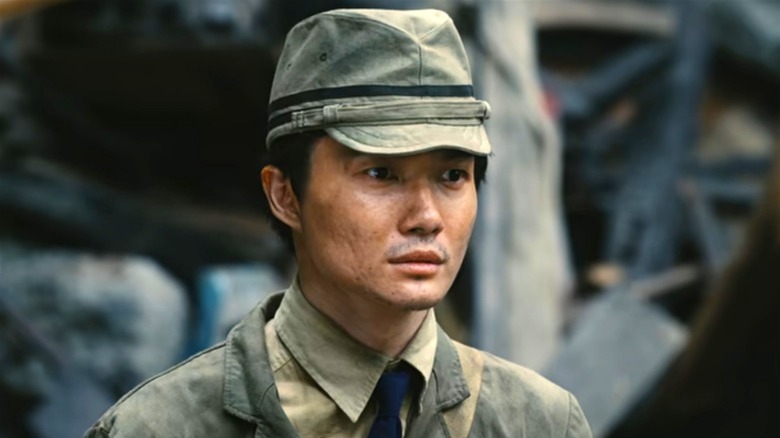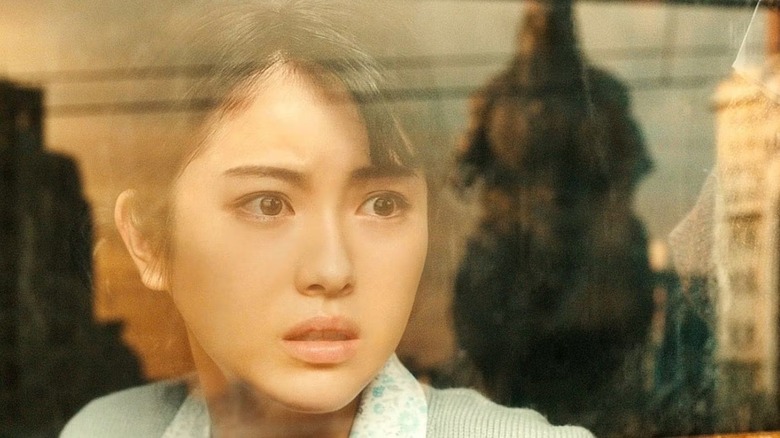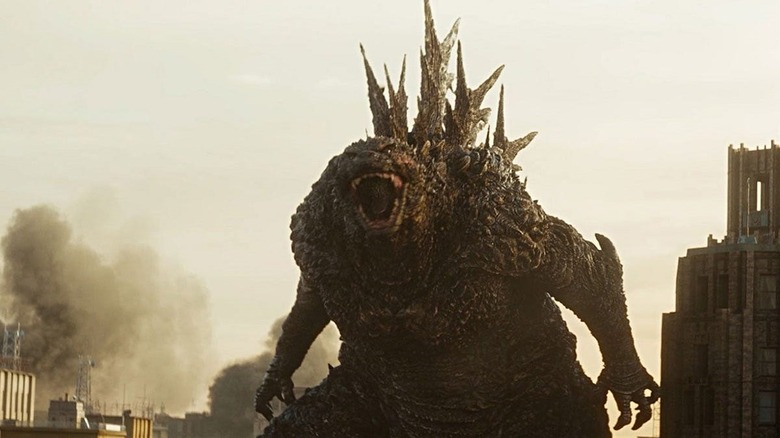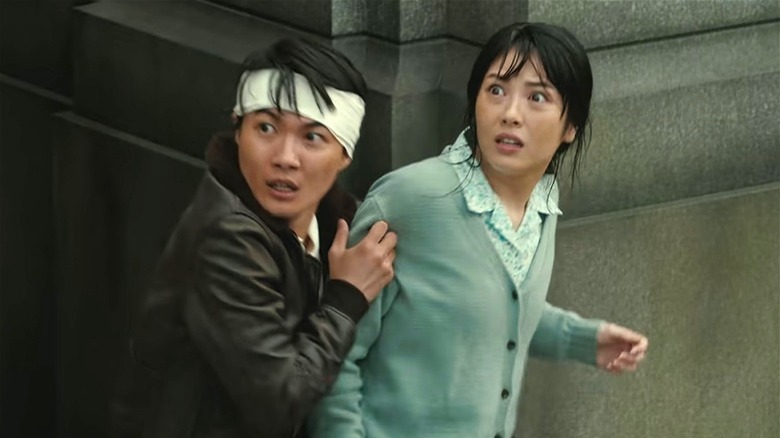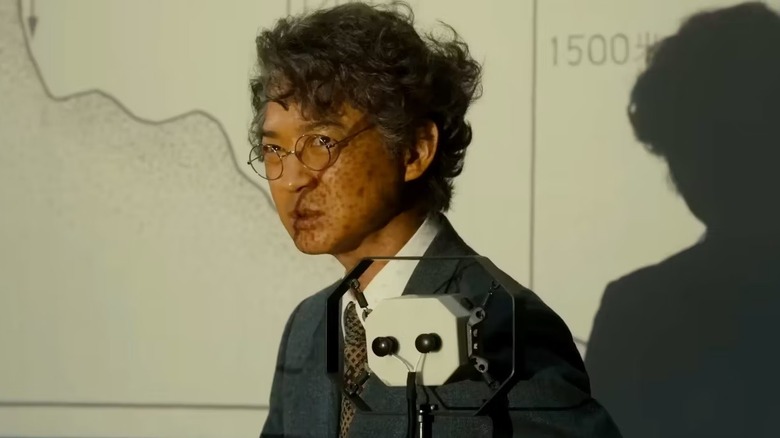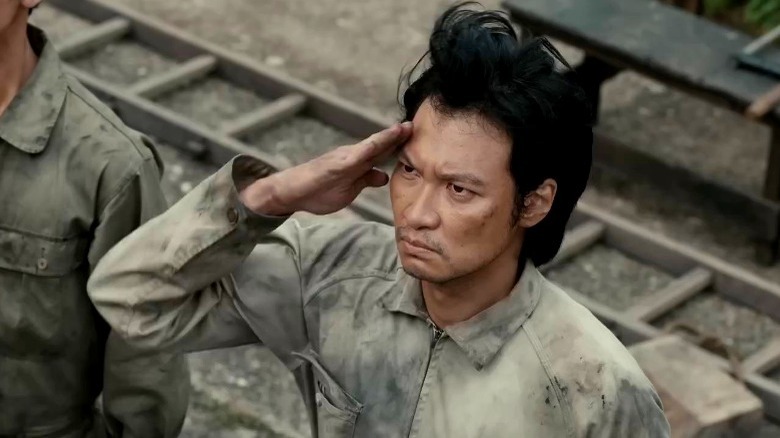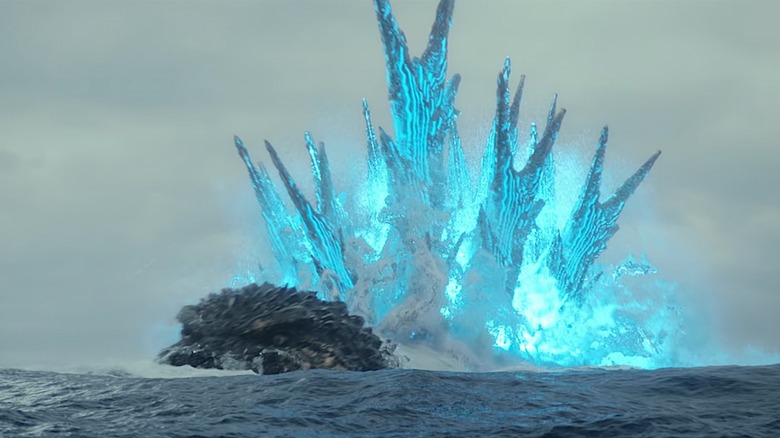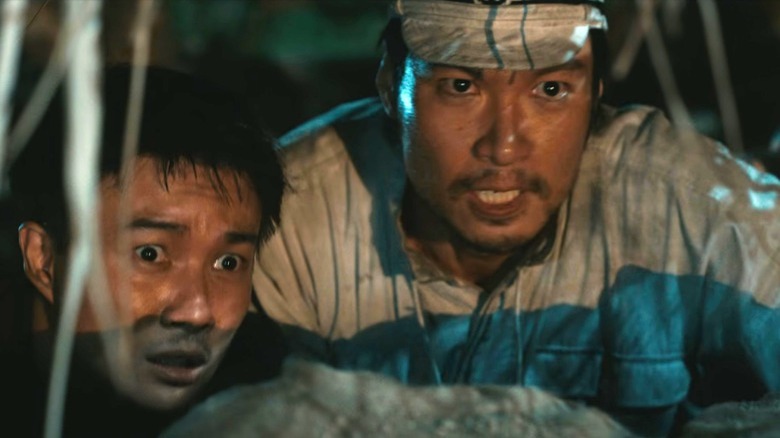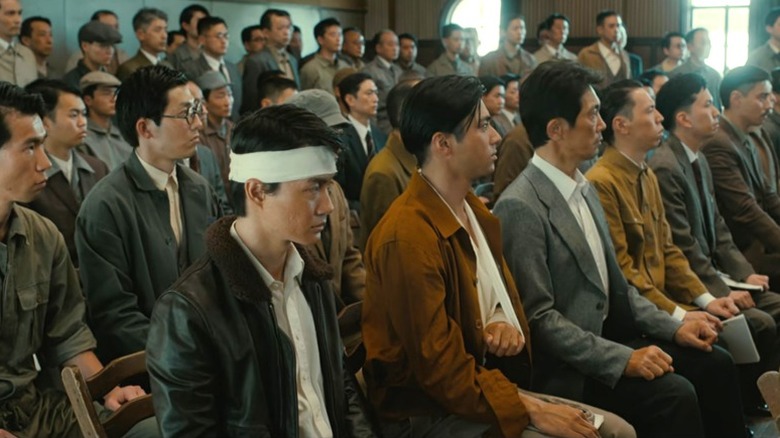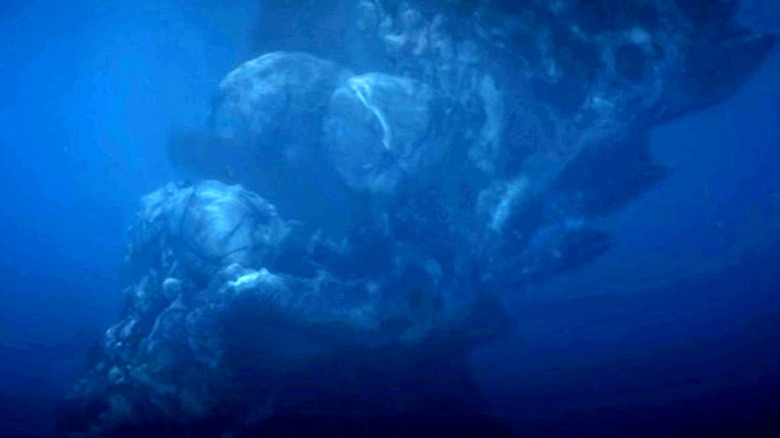The Biggest Unanswered Questions In Godzilla Minus One
Contains spoilers for "Godzilla Minus One"
"Godzilla Minus One" is that rare treat: a life-affirming monster movie. It's mostly set in Japan not long after WWII Japan and follows the story of a kamikaze pilot who abandons his final mission, only to be haunted by it. Soon, he faces two new foes — unending grief, and Godzilla, a giant, radioactive monster hellbent on destroying Japan. This killer kaiju epic is an examination of life after and during trauma, an exploration of guilt, a condemnation of war, and a poignant tribute to the power of regrowth as communities large and small come together to survive (and even thrive) in an otherwise unbearable world.
Written and directed by Takashi Yamazaki, 2023's "Godzilla Minus One" does away with some of the sillier things that Godzilla movies have become known (and even loved) for. Yamazaki's film references Godzilla's roots as a symbol of atomic fears and the specter of sudden attack, like in the first-ever Godzilla film, 1954's "Gojira." It might just be the most visually stunning and emotionally powerful kaiju movie since Guillermo del Toro's "Pacific Rim." However, while it's a fairly straightforward (and kickass) monster movie, it leaves a few unanswered questions that have us stroking our scaly little heads with a curious claw. Read on as we sail through the biggest unanswered questions in "Godzilla Minus One."
What does the title actually mean?
"Godzilla Minus One" is a metal-sounding title for a Godzilla movie, but what does the phrase actually mean? At first glance, the title makes it seem like this film's Godzilla might be less developed than the ones of yesteryear, when actually, the mutated monster is more super-powered than ever. The title of the film is actually a reference to the fact that, after the end of World War II, Japan was at "zero" — things couldn't possibly be worse for the country. At least, until a lumbering killer kaiju comes along. "The biggest [meaning] is how people rise up from a post-war Japan that is at zero, and then Godzilla arrives, making the situation even worse and more tragic," Yamazaki confirmed at a 2023 Toho Studios press conference (via Netflix's Tudum).
Yamazaki expanded on the different meanings that "minus one" could take as reflected on the film's setting: It unfolds in 1945 in the direct aftermath of the war and before the original "Godzilla" film. "In that sense it is also a 'minus one,'" he said, adding, "It is also a 'minus one' in the sense of a run-up — a pull-back [that allows you to] get back on your feet in the face of difficult times. It can also be a 'minus one' of losing something, and I hope that people will feel the various meanings in this film as they watch it." Every character in the film experiences a loss or some sense of diminishment, which is part of what made the movie so relatable to the global audience it attracted, even before "Godzilla Minus One" had a history-making release on Netflix.
Why does Godzilla move so slowly?
Godzilla is always difficult to defeat in his movies, but the monster seems pretty much impossible to kill in "Godzilla Minus One." When former kamikaze pilot Koichi Shikishima (Ryunosuke Kamiki) and mechanic Sosaku Tachibana (Munetaka Aoki) first confront Godzilla on Odo Island, the murderous monster is almost lightning-fast in comparison to when we see him lumbering through Ginza years later. There, and throughout the rest of the film, Godzilla seems to gain strength from taking damage, apparently capable of regeneration. While it is only indirectly referenced in a montage, Godzilla's evolving mutant powers come from getting mixed up with Operation Crossroads in 1946, the first atmospheric nuclear weapons testing since the U.S. dropped bombs on Hiroshima and Nagasaki.
Speaking to Maxon about Godzilla's powerset in this latest installment, director Takashi Yamazaki said: "The Godzilla character that was first seen on Odo Island was written as Gojira and based on the concept of a dinosaur-like sea monster with incredible regenerative abilities. It became Godzilla through a process of regeneration after being burned in the nuclear blast of Operation Crossroads." Yamazaki also talked about Godzilla's seemingly all-powerful status after the radiation exposure in an interview with Toho Kingdom, saying: "Godzilla was more of a creature, but after its exposure, it became this... it almost elevated itself to almost a divine or god-like creature." Apparently the one drawback to being a god-like creature is incredibly slow reflexes to go with all of that extremely destructive power.
Does Godzilla hate Japan?
Even for those familiar with Godzilla, the monster's symbolism may be a tad unclear these days. In the first Godzilla film, the creature was a metaphor for the devastating atomic bombing of Japan toward the end of World War II, though this message wasn't relayed to American moviegoers when the film made its way to the States. "Certainly all the pieces that were in any way, could in any way be construed as critical of the United States or atomic testing, were really stricken from the film," William Tsutsui, author of "Godzilla on My Mind: Fifty Years of the King of Monsters," told NBC. That meaning has changed in the many Godzilla movies since, but Takashi Yamazaki took the monster back to its original meaning and then some.
The director told The Verge that Godzilla is an embodiment of nuclear war and the fear it still strikes in the hearts of Japanese people, adding: "We — humans — we're not necessarily there to kill Godzilla. We're there to calm him. 'Minus One' is about putting a name and face to something scary and inviting the audience to calm that negative presence through the shared experience of watching the film." This is a very Japanese way of thinking, the filmmaker said, and this is what ultimately gave birth to kaiju. Making a kaiju film is a way to give these often unspoken feelings a physical presence. "You place these problems into the shape of a kaiju to help process some of these worries, almost like a ceremony," he told Letterboxd. Godzilla doesn't hate Japan, it's the living representation of the country's loss and fear.
How did Shikishima find Noriko in Ginza?
It's stomach-churning to watch Godzilla decimate Ginza, especially on the very same day Noriko Oishi (Minami Hamabe) has gotten herself all spiffed up to take a job in the city. Noriko starts her day full of post-war, Shōwa era promise, and it soon turns into Godzilla biting her train car in half. All of Godzilla's radioactive wrath is on display in Ginza, and the scene is sheer chaos — which makes Koichi Shikishima's sudden appearance by Noriko's side all the more surprising. Or extremely convenient. Also a puzzler: Why does Noriko save Shikishima but not herself during Godzilla's breath blast attack? Noriko has a will to survive. It's Shikishima with the death wish. Still, she pushes him to safety and takes the blast herself. It's an impulsive move, but it's hard to understand her logic.
Is all of this convenient movie magic, or by design? According to Takashi Yamazaki, the unpredictability is there to keep viewers guessing. "I see character arcs like a roller coaster. So before I throw them into the absolute pit, I wanted to bring them up a little bit before they go down." he told Paste magazine. "Like, there was one moment where Shikishima said, 'Is it okay for me to be happy?' And then bang!" The "bang" he's referring to is Godzilla's rampage through Ginza, which comes as a shock to viewers as well as the characters. "I think audiences like seeing characters as they crawl their way back to a certain mindset, or state," the director added. The interactions between Shikishima and Noriko may seem random at times, but their connection is an important anchor point on the former's journey to self acceptance.
How does Doc Noda know so much?
Dr. Kenji Noda (Hidetaka Yoshioka), or "Doc," sure knows an awful lot about Godzilla for someone who supposedly just met the creature while out minesweeping. There are many question marks hanging over this character. How does he know the exact amount of days it will take Godzilla to return to Tokyo? How long has he been cooking up his complex, resource-heavy plan to take Godzilla down? How does he know Godzilla is recharging his heat ray? Did he think ahead to record Godzilla's voice in the first attack, knowing he'd want to use it later to lure Godzilla? Did he coordinate the deployment of the radioactivity detection buoys? Was his minesweeper job actually a cover for this work all along? Or is Noda just the bearer of plot devices? To be fair, in a Godzilla movie, someone's got to be.
Most of these questions will probably remain unanswered, though one Noda mystery has been solved by director Takashi Yamazaki. When asked how and when Godzilla's roar recording was taken during an interview with Toho Kingdom, Yamazaki said that they "discover a tape from the news crew after the building collapsed and obtained the recording from there." This information is "actually revealed in the novelized version of the film," the filmmaker added. There's more to Noda's story than the movie lets on, but you'll have to read the book if you want to satisfy your curiosity. It's only available in Japanese at the time of this writing, but Yamazaki suggested that translations could be in the pipeline.
Why does Shikishima need Tachibana to fix the plane?
Shikishima antagonizes Tachibana, the mechanic he once betrayed, into joining forces so they can fight Godzilla. But why does Shikishima need the mechanic who loathes him to help when he could have found a local mechanic faster, one who isn't going to punch him in the eye for his past misdeeds? While the movie doesn't spell this out, it's likely because of Shikishima's craving for redemption. Shikishima tells Tachibana that he's willing to die this time, to do what's right, and, it's implied, to pay the life price he should have paid so long ago, the price that Tachibana's crew paid instead. This seals the deal for Tachibana.
While the movie doesn't follow Tachibana's story after the war, he seems just as lost as Shikishima. Their war isn't over, but, by the ending of "Godzilla Minus One," they both have something akin to closure. They survive and help Tokyo do the same — at least until the next monster attack. "Live," Tachibana urges Shikishima in a flashback scene that reveals he installed an ejector seat. In this moment, Tachibana is urging himself to do the same. Shikishima and Tachibana are flip sides of the same coin: A man who did his duty, and a man who didn't. Both have been struggling with survivor's guilt. Coming together like they do helps them look forward instead of into the past.
Why were civilians not warned about Godzilla?
Yōji Akitsu (Kuranosuke Sasaki), captain of the minesweeping ship, often has a damning word to say about the people running post-war Japan. It tallies with real history: The administration's secrecy around radiation, general misinformation, and corruption might be some reasons for Akitsu's ire. By the time Godzilla strikes Japan, audiences likely share Akitsu's disgust for the lack of support on the government's behalf. While the official reason for the inaction with Godzilla is to avoid causing panic, a giant killer monster appearing without warning causes plenty. It turns out that the people in power doing little to help in an emergency was inspired by more recent events.
Speaking to The Verge, director Takashi Yamazaki revealed that Japan's reaction to the COVID-19 pandemic inspired him. "It was right in the middle of the pandemic when I was first writing that script. In those early first few weeks, we had the sense of, 'Hey, the government's not doing anything. This is going to be up to us,'" he said, adding: "The Japanese government eventually stepped up later, but I wanted this script to reflect the feeling of people realizing that, presented with a problem like Godzilla, they would have to rise to the occasion themselves to survive." Our heroes succeed because they take their fate into their own hands, which is one of the film's main messages.
What do the Odo villagers know about Godzilla?
At the beginning of "Godzilla Minus One," Shikishima lands on Odo Island. When Godzilla attacks the island, one of Tachibana's crewmates names Godzilla and says that the villagers have warned him of this creature. When deep sea fish pop to the surface of the water, Godzilla can't be far behind. Moments after this quick line, the mechanics are dead by Godzilla's hand — er, mouth. So, what exactly do the Odo Island villagers know? Did no one go back to talk to them? How have they dealt with Godzilla before? How many villagers have been lost to him? Do the villagers have any tips and tricks for dealing with this menace? Possibly. But not in this movie.
When asked if there were any more details about this, Takashi Yamazaki admitted to Toho Kingdom that he hadn't come up with any additional backstory. To him, Odo Island and its villagers were just a place to base "urban legend village rumors." He confirmed that no deleted scenes featuring these villagers exist. "It's a throwback to the original Odo Shima, Odo Island where they were offering sacrifices to Godzilla," he said. This is a reference to a scene in the original 1954 Godzilla. It harks back to Odo Island being Godzilla's home base in a more peaceful time (though not so much for the human sacrifices who were tied to rafts and sent off to violent ends).
Why are there so many ex-military men in the Special Disaster Countermeasure group?
The metaphor of the Special Disaster Countermeasure group is absolutely beautiful. If Shikishima's arc toward living is the heart of the movie, this group is certainly the soul. Its formation demonstrates the power communities hold when they come together by choice and necessity, even when the odds are stacked against them. This would be a massive undertaking during times of peace, let alone during a monster attack. So how did this whole thing get set up? On the surface, this is a citizen group dedicated to saving people by any means necessary, government be damned. However, it's hard to ignore the fact that it's full of ex-navy personnel.
It seems likely that membership skews heavily toward ex-military because so many soldiers and officials were disillusioned and traumatized by the war. Many young men from the Japanese military (especially those who were trained to be kamikaze pilots) were unable to settle back into everyday life as citizens, with many becoming delinquents and turning to gang life for a sense of belonging. In the film, they get the chance to do their duty for Japan by saving it from Godzilla. It's heartening to watch these men work to their full potential in order to survive a killer monster rather than to destroy a human enemy.
What is that black mark on Noriko's neck?
"Godzilla Minus One" ends with a powerful reunion for Shikishima, Noriko, and little Akiko (Sae Nagatani). Shikishima is ready to live again and for his new life to be truly shared with Noriko. Of course, there is one small, possibly sinister matter: As Noriko goes to embrace Shikishima, a spidery, black growth blooms up her neck. What is this suspiciously Godzilla-looking growth under Noriko's skin? What could it mean? Does it mean that a "Godzilla Minus One" sequel is going to happen? Takashi Yamazaki addressed some of the fan theories regarding the black mark at Osaka's Godzilla Fest in April 2024, and his comments were met enthusiastically by those in attendance.
The director confirmed that Noriko is now the owner of symbiote-like "G-cells," AKA "Godzilla cells." These cells have deep roots in Godzilla lore, being responsible for the creation of two iconic foes: Biollante and SpaceGodzilla. "In 1989's 'Godzilla vs. Biollante,' a scientist named Genichiro Shiragami splices the cells of his deceased daughter, a rosebud, and Godzilla's regenerative cells, creating the plant kaiju Biollante," IGN reported after the big reveal. "Godzilla's subsequent victory over Biollante would prove pyrrhic because her G-cells mixes with a black hole (after Godzilla yetes her into outer space), leading to the creation of SpaceGodzilla." Whether this cliffhanger moment was just a nod to the franchise's past or a hint at what's to come remains to be seen.
What is going on with that Godzilla shard?
As if Noriko's G-cell tattoo wasn't foreboding enough, the last teeny-tiny scene of "Godzilla Minus One" asks the biggest question of all: What is going on with that Godzilla shard? We cut to the bottom of the sea, where a piece of Godzilla's body seems to be regenerating. What looks like egg sacs balloon open in the movie's final moments. The image is disgusting, yet thrilling. Is this part of the regeneration process, or are little Godzilla babies about to be born? Should we warn SpongeBob?
In all seriousness, this striking image truly makes us wonder if we're on the verge of a whole new era of Godzilla films. "Godzilla Minus One" stands on its own as a film about living again after trauma: After all, while monsters may be everywhere, so are reasons to live. If there's a follow-up, will it delve deeper into this theme, or does Takashi Yamazaki — assuming he would be involved — have other messages he wants to put across? Only time will tell. While you wait for confirmation on a sequel, go ahead and check out our list of the best (and the worst) "Godzilla" movies ever made.
